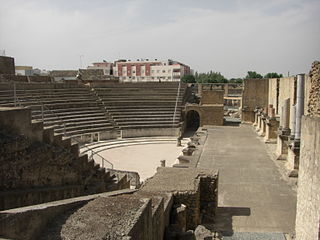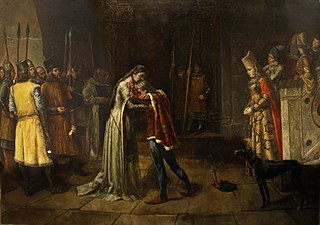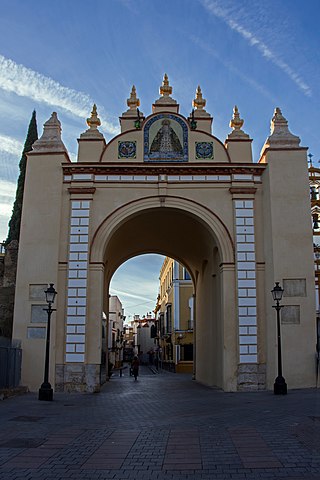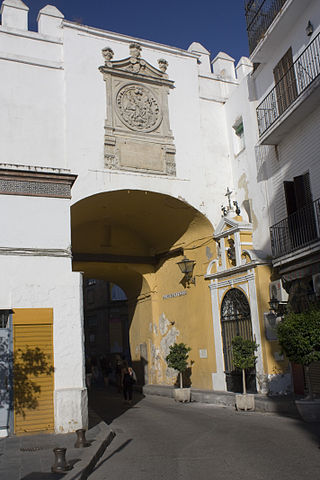"Macarena" is a 1993 song by Los del Río most well known for its 1995 remix, as well as the name of its accompanying dance.

An alcázar, from Arabic al-Qasr, is a type of Islamic castle or palace in Spain built during Muslim rule between the 8th and 15th centuries. They functioned as homes and regional capitals for governmental figures throughout the Umayyad caliphate and later for Christian rulers following the Iberian Reconquista. The term alcázar is also used for many medieval castles built by Christians on earlier Roman, Visigothic or Islamic fortifications and is frequently used as a synonym for castillo or castle. In Latin America there are also several colonial palaces called alcázars.
San Fernando may refer to:

Carmona is a town of southwestern Spain, in the province of Seville; it lies 33 km north-east of Seville.

Plasencia is a municipality of Spain belonging to the province of Cáceres, Extremadura. As of 2013, it has a population of 41,047.

The Cathedral of Saint Mary of the See, better known as Seville Cathedral, is a Catholic cathedral and former mosque in Seville, Andalusia, Spain. It was registered in 1987 by UNESCO as a World Heritage Site, along with the adjoining Alcázar palace complex and the General Archive of the Indies. It is one of the largest churches in the world as well as the largest Gothic cathedral.

Seville has been one of the most important cities in the Iberian Peninsula since ancient times; the first settlers of the site have been identified with the Tartessian culture. The destruction of their settlement is attributed to the Carthaginians, giving way to the emergence of the Roman city of Hispalis, built very near the Roman colony of Itálica, which was only 9 km northwest of present-day Seville. Itálica, the birthplace of the Roman emperors Trajan and Hadrian, was founded in 206–205 BC. Itálica is well preserved and gives an impression of how Hispalis may have looked in the later Roman period. Its ruins are now an important tourist attraction. Under the rule of the Visigothic Kingdom, Hispalis housed the royal court on some occasions.

Leonor (Eleanor) de Guzmán y Ponce de León (1310–1351) was a Castilian noblewoman. After about 1330, she became the long-term mistress and favourite of Alfonso XI, with whom she had the illegitimate son Henry "the Fratricidal", future first monarch of the House of Trastámara. She held the lordship of Medina-Sidonia until she fell from grace in the wake of Alfonso's death in 1350. She was then executed by her enemies.

The Alcázar of Seville, officially called Royal Alcázar of Seville, is a historic royal palace in Seville, Spain. It was formerly the site of the Islamic-era citadel of the city, begun in the 10th century and then developed into a larger palace complex by the Abbadid dynasty and the Almohads. After the Castilian conquest of the city in 1248, the site was progressively rebuilt and replaced by new palaces and gardens. Among the most important of these is a richly-decorated Mudéjar-style palace built by Pedro I during the 1360s.

Isabella, Princess of Asturias was the eldest daughter and heiress presumptive of King Ferdinand II of Aragon and Queen Isabella I of Castile. She was Queen of Portugal as the wife of King Manuel I from 30 September 1497 until her death the following year.

Macarena is one of the eleven districts into which the city of Seville, capital of the autonomous community of Andalucía, Spain, is divided for administrative purposes. It is located in the north of the city, bordered to the south by the Casco Antiguo and San Pablo-Santa Justa suburbs, to the east and north by Norte and to the west by Triana. It covers the area between the Guadalquivir River and the Carmona Highway and from the SE-30 ring-road in the north to the Ronda del Casco Antiguo. It contains smaller neighbourhoods such as León XIII, Miraflores, and the Polígono Norte as well as the Miraflores park along the SE-30. The district contains the Andalucian Parliament, the Torre de los Perdigones in the park of the same name, and the Hospital Universitario Virgen Macarena

Isabella I, also called Isabella the Catholic, was Queen of Castile and León from 1474 until her death in 1504. She was also Queen of Aragon from 1479 until her death as the wife of King Ferdinand II. Reigning together over a dynastically unified Spain, Isabella and Ferdinand are known as the Catholic Monarchs.

The history of Carmona begins at one of the oldest urban sites in Europe, with nearly five thousand years of continuous occupation on a plateau rising above the vega (plain) of the River Corbones in Andalusia, Spain. The city of Carmona lies thirty kilometres from Seville on the highest elevation of the sloping terrain of the Los Alcores escarpment, about 250 metres above sea level. Since the first appearance of complex agricultural societies in the Guadalquivir valley at the beginning of the Neolithic period, various civilizations have had an historical presence in the region. All the different cultures, peoples, and political entities that developed there have left their mark on the ethnographic mosaic of present-day Carmona. Its historical significance is explained by the advantages of its location. The easily defended plateau on which the city sits, and the fertility of the land around it, made the site an important population center. The town's strategic position overlooking the vega was a natural stronghold, allowing it to control the trails leading to the central plateau of the Guadalquivir valley, and thus access to its resources.
The tenth siege of Gibraltar in 1506 was a minor military action in which the Duke of Medina Sidonia, Juan Alfonso Pérez de Guzmán tried but failed to recover the fortress of Gibraltar from the troops who were holding it in the name of the newly united crowns of Castile and Aragon.

The Walls of Seville are a series of defensive walls surrounding the Old Town of Seville. The city has been surrounded by walls since the Roman period, and they were maintained and modified throughout the subsequent Visigoth, Islamic and finally Castilian periods. The walls remained intact until the 19th century, when they were partially demolished after the revolution of 1868. Some parts of the walls still exist, especially around the Alcázar of Seville and some curtain walls in the barrio de la Macarena.

The Seville Shipyard is a medieval shipyard in the city of Seville that operated from the 13th to the 15th century. Composed of seventeen naves, the building was connected to the Guadalquivir River by a stretch of sand.
The Walls del Arrabal were the third in a set of five walls built around Madrid, now the capital of Spain. There are no remaining ruins of the Walls del Arrabal, leaving some debate as to their extent and the period of their construction. It is possible that the walls were built as early as the 12th century, however they were most likely constructed in 1438. The walls may have been intended to protect people against the plagues that ravaged the city at the time. The walls united the urbanized suburbs of the city and prevented entry of the infected.

The Puerta de la Macarena, also known as Arco de la Macarena, is one of the only three city gates that remain today of the original walls of Seville, alongside the Postigo del Aceite and the Puerta de Córdoba. It is located in the calle Resolana, within the barrio de San Gil, which belongs to the district of Casco Antiguo of the city of Seville, in Andalusia, Spain. The gate faces the Basílica de La Macarena, which houses the image of the Our Lady of la Esperanza Macarena, one of the most characteristic images of the Holy Week in Seville.

The Postigo del Aceite is with the Puerta de la Macarena and Puerta de Córdoba the only three access preserved in today of those who had the walls of Seville, Andalusia, Spain.
The Puerta de Triana was the generic name for an Almohad gate which was later on replaced by a Christian gate at the same place. It was one of the gates of the walled enclosure of Seville (Andalusia).















